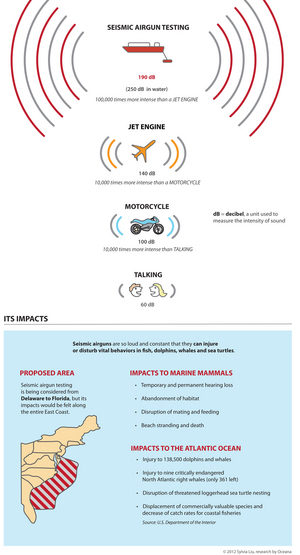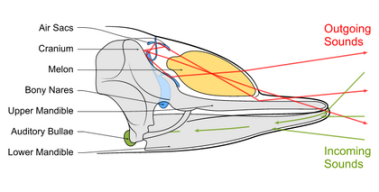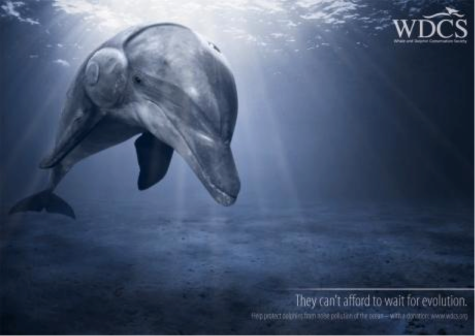Here is a picture of Sola and I. Check out her beautiful features on her face!
Dolphins have a pair of eyes that move independently of one another! With a layer of protective film that protects the eye from harmful pathogens in the water. They can see clearly both above and under water. Do you think dolphins have ears?
If you say yes, you’re right!
Yes! Dolphins have ears too! Take a close look to see if you can spot the tiny pin-hole-like ear just behind her eye.
“HERE!” “NO! OVER HERE!” “WHAT?” “WAIT HUH?”
The ocean is so much noisier than we think it is.
Many anthropogenic activities such as commercial shipping, offshore gas and oil drilling, and navy military activities in the sea has contributed to a significant amount of noise pollution to our marine animals in the ocean.

Noise pollution as we know disturbs and affects our daily activities. But for these marine animals, cetaceans in particular, they have it off even worse than we can imagine. Here is why…
Cetaceans are highly dependent on echolocation and sound in their environments. These mammals themselves produce a variety of sounds that are essential for foraging, navigation, communication, and sensing the environment especially when it is dark, and when they don’t have their sense of sight to help them.
Imagine being placed in a dark room with about 10 people shouting instructions to you on how to move around to reach your end point. Likewise, it is the same for them.
Odontocetis, like dolphins (bottlenose dolphins and orcas), produce echolocation clicks in the ultrasonic frequencies, and lower-frequency tonal whistles for communications. They are highly sensitive to sounds over a broad frequency range of 20-140kHz, varying across each species.
Mystecetis on the other hand, the baleen whales (humpback whales and blue whales), produce longer, lower-frequency tonal sounds for communication. The specific frequency range for hearing sensitivity for this group of mammals are unclear with only few anatomical studies conducted that give us an estimated 10-20kHz answer.

The IWDG (Irish Whale and Dolphin Group) have listed the following consequences on cetaceans as a result of the use of high frequency sounds in anthropogenic activities
- Physiological damage
Damage to body tissues, and particularly the ears.
Just like humans, experiencing a high frequency sound can cause serious damage to the auditory system. Ultimately, stress factors had led to increase heart rate and respiratory rates, affecting their overall well being. - Perceptual consequence
When certain frequencies used by machinery overlaps with the frequency that cetaceans use for communication and echo-location, these poor creatures get confused and are sometimes misled. This leads to the next point of… - Behavioral changes
With foreign sounds invading into their habitat, these cetaceans tend to flee from them, causing major disruptions in their feeding, breeding (migration related) and resting locations. This displacement can cause changes to ecosystems in certain areas.

Photo credits: http://cetussociety.org/2015/07/whats-all-the-underwater-buzz-about-underwater-noise-and-cetacean-health/
What is being done then?
Many researchers have conducted experiments to find out each species frequency sensitivity range. This data collected and strategies suggested by experts are then passed on to marine experts who work together with businesses engaged in anthropogenic activities to minimize the impact of our actions to the cetacean community.
Understanding each species peaked sensitivity and frequency threshold, that is – the frequencies that they are acutely sensitive to, is crucial when we venture into their environments for future human developments such as offshore drilling. Sounds travel 4.5 times faster in water than it does in air, while low frequency sounds travel farther underwater than high frequency sounds. Anthropogenic activities such as offshore drilling and military exercises can produce ear-piercing equivalent sounds that result in a lot of physiological damage and behavioural alterations.
There isn’t much as an individual that I can do or help these creatures in this aspect, unless I can create a GPS for each species. I can only hope that these businesses do contribute and put in the effort to ensure that strategies proposed are adhered to as much as possible, to improve the lives of these cetaceans that we had disrupted.
References:
O’ Brien, Joanne, Simon Berrow, and Dave Wall. ‘The Impact Of Multibeam On Cetaceans: A Review Of Best Practice’. The Irish Whale and Dolphin Group (2005): n. pag. Print.

